Mapping Alteration Minerals Associated with Aktogay Porphyry Copper Mineralization in Eastern Kazakhstan Using Landsat-8 and ASTER Satellite Sensors
Abstract
1. Introduction
2. Geological Settings of the Study Area
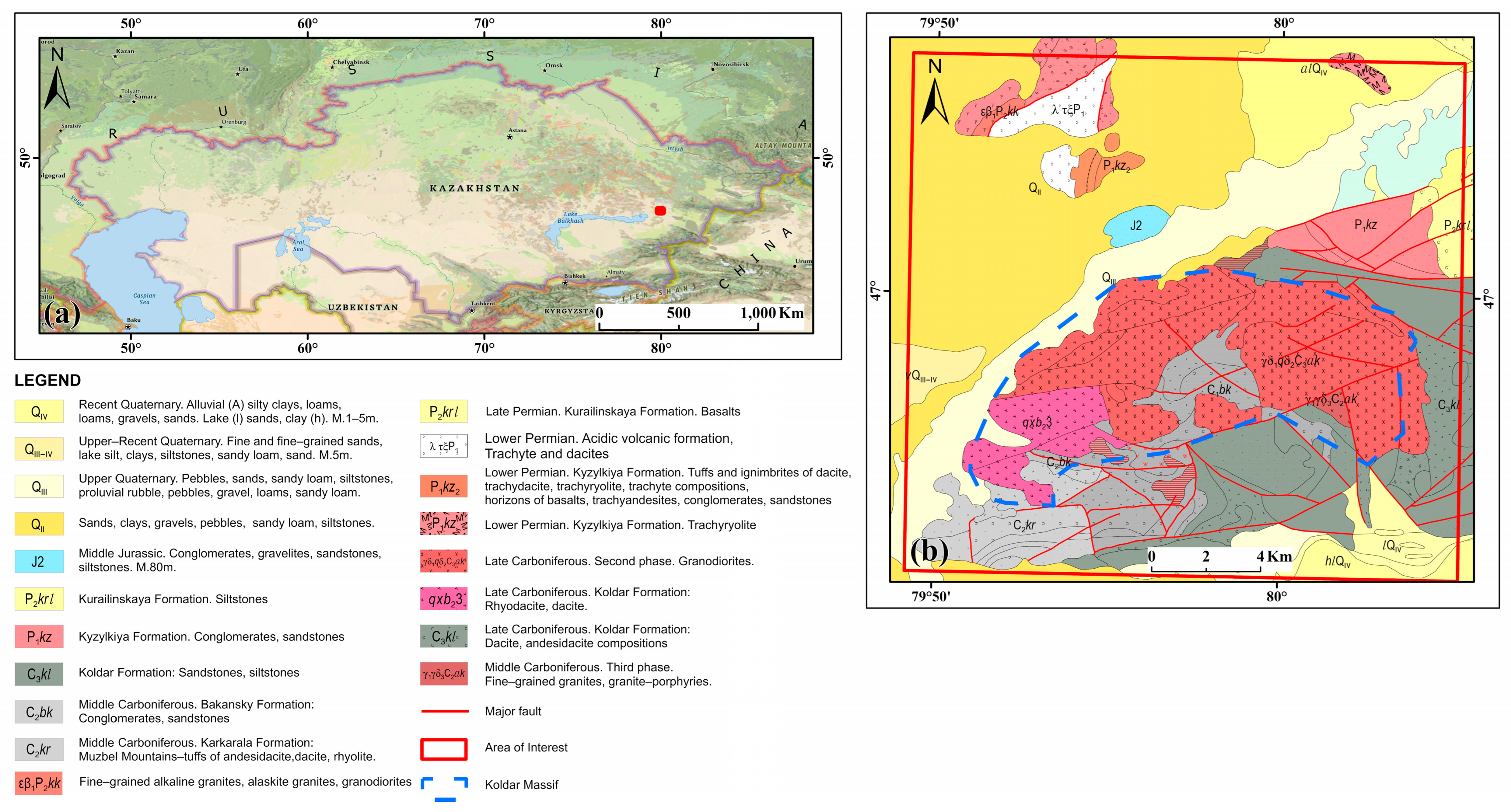
3. Materials and Methods
3.1. Characteristics of Remote Sensing Data
3.2. Methods
3.2.1. False-Color Composite (FCC)
3.2.2. Band Ratio (BR) Math Analysis
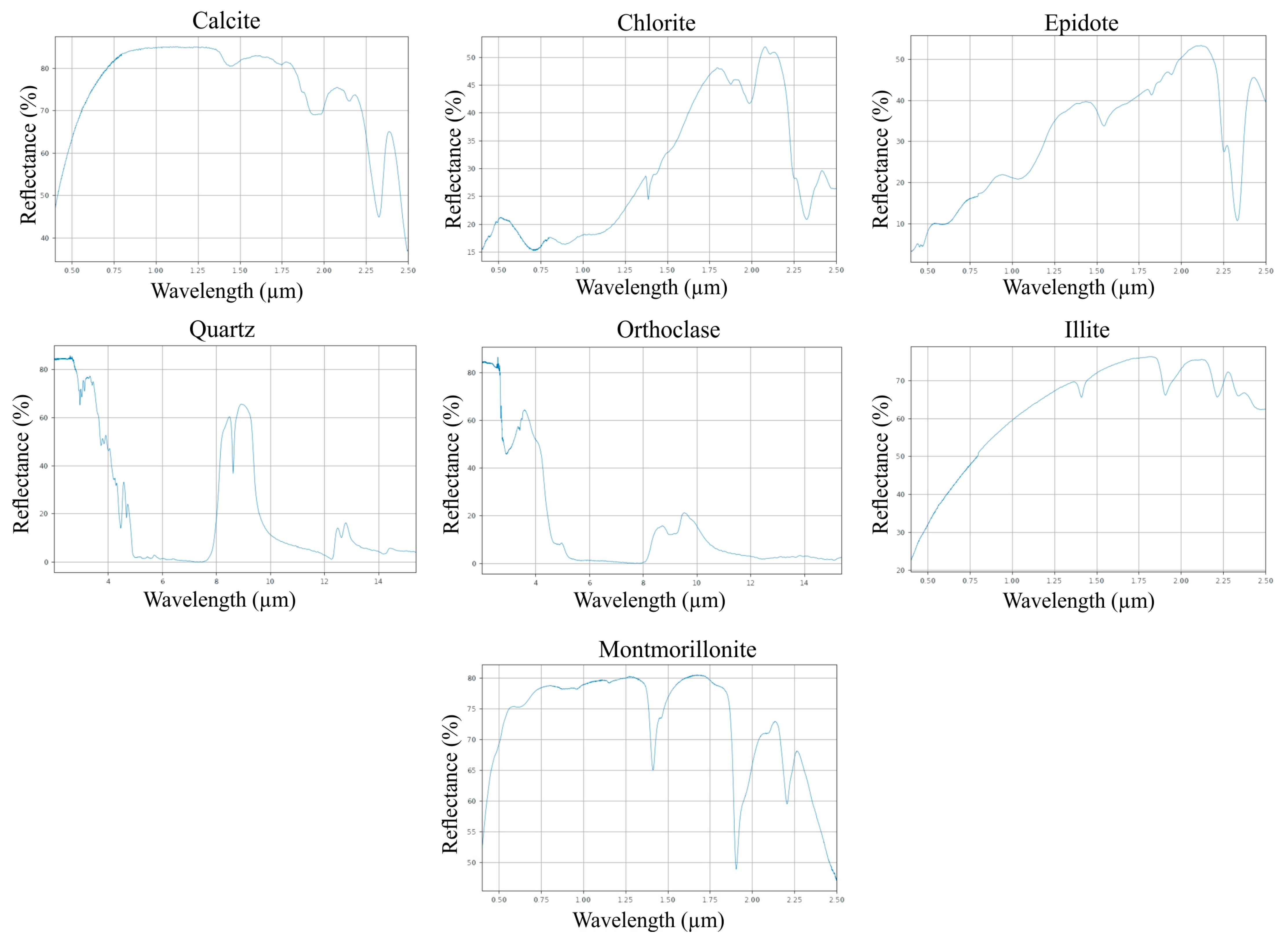
3.2.3. Principal Component Analysis (PCA)
3.2.4. Crosta Technique
3.2.5. Automated Lineament Extraction
4. Results
4.1. Mapping Alteration Zones and Minerals
4.2. Verification of the Image Processing Results
5. Discussion
6. Conclusions
Author Contributions
Funding
Data Availability Statement
Acknowledgments
Conflicts of Interest
References
- Smirnova, I.O.; Kirsanov, A.A.; Kamyshnikova, N.V. A review of the past 5 years of international advances in multi- and hyperspectral satellite data application and processing techniques in geological research. Sovrem. Probl. Distantsionnogo Zo. Zemli Iz Kosmosa 2020, 17, 9–27. [Google Scholar] [CrossRef]
- Ahmadi, H.; Uygucgil, H. Targeting iron prospective within the Kabul Block (SE Afghanistan) via hydrothermal alteration mapping using remote sensing techniques. Arab. J. Geosci. 2021, 14, 183. [Google Scholar] [CrossRef]
- Akhmetov, R.; Makhmetova, G.; Orynbassarova, E.; Baltiyeva, A.; Togaibekov, A.; Roberts, K.; Yerzhankyzy, A. The Study of Kinematic Gnss Surveying for Bim Georeferencing. Int. Arch. Photogramm. Remote Sens. Spat. Inf. Sci. 2022, XLVI-5/W1-, 7–14. [Google Scholar] [CrossRef]
- Mohebi, A.; Mirnejad, H.; Lentz, D.; Behzadi, M.; Dolati, A.; Kani, A.; Taghizadeh, H. Controls on porphyry Cu mineralization around Hanza Mountain, south-east of Iran: An analysis of structural evolution from remote sensing, geophysical, geochemical and geological data. Ore Geol. Rev. 2015, 69, 187–198. [Google Scholar] [CrossRef]
- Zhang, T.; Yi, G.; Li, H.; Wang, Z.; Tang, J.; Zhong, K.; Li, Y.; Wang, Q.; Bie, X. Integrating Data of ASTER and Landsat-8 OLI (AO) for Hydrothermal Alteration Mineral Mapping in Duolong Porphyry Cu-Au Deposit, Tibetan Plateau, China. Remote Sens. 2016, 8, 890. [Google Scholar] [CrossRef]
- Pour, A.B.; Hashim, M.; Hong, J.K.; Park, Y. Lithological and alteration mineral mapping in poorly exposed lithologies using Landsat-8 and ASTER satellite data: North-eastern Graham Land, Antarctic Peninsula. Ore Geol. Rev. 2019, 108, 112–133. [Google Scholar] [CrossRef]
- Rajendran, S.; Majed Said AL-Dhuhli, A.; Hazaa Saif Al-Ali, H. Discrimination of copper mineralized zone of part of sultanate of Oman using remote sensing technique. In Proceedings of the 12th EAGE International Conference on Geoinformatics-Theoretical and Applied Aspects, Kiev, Ukraine, 13–16 May 2013. [Google Scholar]
- Shebl, A.; Abdellatif, M.; Elkhateeb, S.O.; Csámer, Á. Multisource Data Analysis for Gold Potentiality Mapping of Atalla Area and Its Environs, Central Eastern Desert, Egypt. Minerals 2021, 11, 641. [Google Scholar] [CrossRef]
- Eldosouky, A.M.; Abdelkareem, M.; Elkhateeb, S.O. Integration of remote sensing and aeromagnetic data for mapping structural features and hydrothermal alteration zones in Wadi Allaqi area, South Eastern Desert of Egypt. J. Afr. Earth Sci. 2017, 130, 28–37. [Google Scholar] [CrossRef]
- Alimohammadi, M.; Alirezaei, S.; Kontak, D.J. Application of ASTER data for exploration of porphyry copper deposits: A case study of Daraloo–Sarmeshk area, southern part of the Kerman copper belt, Iran. Ore Geol. Rev. 2015, 70, 290–304. [Google Scholar] [CrossRef]
- Bolouki, S.M.; Ramazi, H.R.; Maghsoudi, A.; Pour, A.B.; Sohrabi, G. A remote sensing-based application of bayesian networks for epithermal gold potential mapping in Ahar-Arasbaran area, NW Iran. Remote Sens. 2020, 12, 105. [Google Scholar] [CrossRef]
- Ranjbar, H.; Honarmand, M.; Moezifar, Z. Application of the Crosta technique for porphyry copper alteration mapping, using ETM+ data in the southern part of the Iranian volcanic sedimentary belt. J. Asian Earth Sci. 2004, 24, 237–243. [Google Scholar] [CrossRef]
- Orynbassarova, E.O.; Adebiyet, B.; Iliuf, F.A.; Sydyk, N.K. Analysis of mineral indices from remote sensing: A case-study of the Tokrau river. Eurasian Min. 2024, 1, 71–76. [Google Scholar] [CrossRef]
- Rahmani, N.R.; Ahmadi, H.; Rahimy, F.; Yousufi, A. Automated detection of granitic complexes in NW Parwan, NE Afghanistan using Sentinel-2B/MSI and ASTER data. Discov. Geosci. 2024, 2, 86. [Google Scholar] [CrossRef]
- Yazdi, Z.; Jafari Rad, A.; Aghazadeh, M.; Afzal, P. Alteration Mapping for Porphyry Copper Exploration Using ASTER and QuickBird Multispectral Images, Sonajeel Prospect, NW Iran. J. Indian Soc. Remote Sens. 2018, 46, 1581–1593. [Google Scholar] [CrossRef]
- Windley, B.F.; Xiao, W. Ridge subduction and slab windows in the Central Asian Orogenic Belt: Tectonic implications for the evolution of an accretionary orogen. Gondwana Res. 2018, 61, 73–87. [Google Scholar] [CrossRef]
- Xu, X.-W.; Li, H.; Peters, S.G.; Qin, K.-Z.; Mao, Q.; Wu, Q.; Hong, T.; Wu, C.; Liang, G.-L.; Zhang, Z.-F.; et al. Cu-rich porphyry magmas produced by fractional crystallization of oxidized fertile basaltic magmas (Sangnan, East Junggar, PR China). Ore Geol. Rev. 2017, 91, 296–315. [Google Scholar] [CrossRef]
- Fu, Y.; Cheng, Q.; Jing, L.; Ye, B.; Fu, H. Mineral Prospectivity Mapping of Porphyry Copper Deposits Based on Remote Sensing Imagery and Geochemical Data in the Duolong Ore District, Tibet. Remote Sens. 2023, 15, 439. [Google Scholar] [CrossRef]
- Liu, C.; Qiu, C.; Wang, L.; Feng, J.; Wu, S.; Wang, Y. Application of ASTER Remote Sensing Data to Porphyry Copper Exploration in the Gondwana Region. Minerals 2023, 13, 501. [Google Scholar] [CrossRef]
- Chouhan, A.K.; Singh, D.; Pal, S.K.; Choudhury, P. Delineation of subsurface geological fractures in the Cambay rift and surrounding regions of NW India: An integrated approach using satellite derived EIGEN-6C4 gravity data. Geocarto Int. 2022, 37, 268–283. [Google Scholar] [CrossRef]
- Chen, Y.; Wang, Y.; Zhang, F.; Dong, Y.; Song, Z.; Liu, G. Remote Sensing for Lithology Mapping in Vegetation-Covered Regions: Methods, Challenges, and Opportunities. Minerals 2023, 13, 1153. [Google Scholar] [CrossRef]
- Wang, Z.; Zuo, R.; Jing, L. Fusion of Geochemical and Remote-Sensing Data for Lithological Mapping Using Random Forest Metric Learning. Math. Geosci. 2021, 53, 1125–1145. [Google Scholar] [CrossRef]
- Khalifa, I.H.; Hegazi, A.M.; Faisal, M. Geological setting for porphyry copper deposits in calc-alkaline rocks: Wadi Rofaiyed area, Sinai, Egypt. Arab. J. Geosci. 2016, 9, 336. [Google Scholar] [CrossRef]
- Deshpande, S.; Subeesh, A.; Saini, A. Analysis of Most Significant Bands and Band Ratios for Discrimination of Hydrothermal Alteration Minerals. In Proceedings of the 2019 10th Workshop on Hyperspectral Imaging and Signal Processing: Evolution in Remote Sensing (WHISPERS), Amsterdam, The Netherlands, 24–26 September 2019; pp. 1–5. [Google Scholar]
- Khosravi, V.; Shirazi, A.; Shirazy, A.; Hezarkhani, A.; Pour, A.B. Hybrid Fuzzy-Analytic Hierarchy Process (AHP) Model for Porphyry Copper Prospecting in Simorgh Area, Eastern Lut Block of Iran. Mining 2021, 2, 1–12. [Google Scholar] [CrossRef]
- Pour, A.B.; Hashim, M. Hydrothermal alteration mapping from Landsat-8 data, Sar Cheshmeh copper mining district, south-eastern Islamic Republic of Iran. J. Taibah Univ. Sci. 2015, 9, 155–166. [Google Scholar] [CrossRef]
- Son, Y.-S.; Kim, K.-E.; Yoon, W.-J.; Cho, S.-J. Regional mineral mapping of island arc terranes in southeastern Mongolia using multi-spectral remote sensing data. Ore Geol. Rev. 2019, 113, 103106. [Google Scholar] [CrossRef]
- Traore, M.; Takodjou Wambo, J.D.; Ndepete, C.P.; Tekin, S.; Pour, A.B.; Muslim, A.M. Lithological and alteration mineral mapping for alluvial gold exploration in the south east of Birao area, Central African Republic using Landsat-8 Operational Land Imager (OLI) data. J. Afr. Earth Sci. 2020, 170, 103933. [Google Scholar] [CrossRef]
- Mahboob, M.A.; Genc, B.; Celik, T.; Ali, S.; Atif, I. Mapping hydrothermal minerals using remotely sensed reflectance spectroscopy data from Landsat. J. South. Afr. Inst. Min. Metall. 2019, 119, 279–289. [Google Scholar] [CrossRef]
- Baibatsha, A.; Arshamov, Y.; Bekbotayeva, A.; Baratov, R. Geology of the main industrial types of copper ore deposits in Kazakhstan. In Proceedings of the International Multidisciplinary Scientific GeoConference, Albena, Bulgaria, 29 June–5 July 2017; SGEM: Varna, Bulgaria, 2017; pp. 231–237. [Google Scholar]
- ZH, D.; HE, Z.; LI, M.; ZH, H.; GA, Y. Analysis of Kazakhstan’s Copper Resources, Development Situation and Investment Potential. Northwest. Geol. 2023, 56, 157–165. [Google Scholar]
- Dyachkov, B.; Mizernaya, M.; Kuzmina, O.; Zimanovskaya, N.; Oitseva, T. Tectonics and Metallogeny of East Kazakhstan. In Tectonics–Problems of Regional Settings; InTech: Houston, TX, USA, 2018. [Google Scholar]
- Hedenquist, J.W.; Harris, M.; Camus, F. Geology and Genesis of Major Copper Deposits and Districts of the World—A Tribute to Richard H. Sillitoe; Society of Economic Geologists: Littleton, CO, USA, 2012; ISBN 978-1-6294-9041-0. [Google Scholar]
- Vikentyev, I.V.; Shatov, V.V.; Smirnov, D.I.; Volchkov, A.G. The Yubileinoe Porphyry Gold–Copper Deposit (Western Kazakhstan): Geological Position and Conditions of Formation. Geol. Ore Depos. 2023, 65, S6–S41. [Google Scholar] [CrossRef]
- Zhu, Y.; An, F.; Feng, W.; Zhang, H. Geological evolution and huge ore-forming belts in the core part of the Central Asian metallogenic region. J. Earth Sci. 2016, 27, 491–506. [Google Scholar] [CrossRef]
- Box, S.E.; Syusyura, B.; Seltmann, R.; Creaser, R.A.; Dolgopolova, A.; Zientek, M.L. Dzhezkazgan and Associated Sandstone Copper Deposits of the Chu-Sarysu Basin, Central Kazakhstan. In Geology and Genesis of Major Copper Deposits and Districts of the World—A Tribute to Richard H. Sillitoe; Society of Economic Geologists: Littleton, CO, USA, 2012. [Google Scholar]
- Yakubchuk, A.; Degtyarev, K.; Maslennikov, V.; Wurst, A.; Stekhin, A.; Lobanov, K. Tectonomagmatic Settings, Architecture, and Metallogeny of the Central Asian Copper Province. In Geology and Genesis of Major Copper Deposits and Districts of the World—A Tribute to Richard H. Sillitoe; Society of Economic Geologists: Littleton, CO, USA, 2012. [Google Scholar]
- Li, G.; Qin, K.; Li, Z. Geological features and tectonic setting of porphyry copper deposits rounding the Balkhash region, Central Kazakhstan, Central Asia. Acta Petrol. Sin. 2008, 24, 2679–2700. [Google Scholar]
- Kakavand, M.; Bonyadi, Z. Evaluation of alteration zones around Parmagasu copper indication, Kuh Zar, Damghan, Iran, using ASTER satellite data. Geocarto Int. 2022, 37, 16827–16845. [Google Scholar] [CrossRef]
- Hosseini, S.; Gholamzadeh, M.; Pour, A.B.; Ahmadirouhani, R.; Sekandari, M.; Bagheri, M. Multi-Sensor Satellite Remote-Sensing Data for Exploring Carbonate-Hosted Pb-Zn Mineralization: Akhlamad Area, Razavi Khorasan, North East Iran. Mining 2024, 4, 367–388. [Google Scholar] [CrossRef]
- Rowan, L.C.; Hook, S.J.; Abrams, M.J.; Mars, J.C. Mapping hydrothermally altered rocks at Cuprite, Nevada, using the Advanced Spaceborne Thermal Emission and Reflection Radiometer (ASTER), a new satellite-imaging system. Econ. Geol. 2003, 98, 1019–1027. [Google Scholar] [CrossRef]
- Mars, J. Regional mapping of phyllic- and argillic-altered rocks in the Zagros magmatic arc, Iran, using Advanced Spaceborne Thermal Emission and Reflection Radiometer (ASTER) data and logical operator algorithms. Geosphere 2006, 2, 161. [Google Scholar] [CrossRef]
- Pour, A.B.; Hashim, M. The application of ASTER remote sensing data to porphyry copper and epithermal gold deposits. Ore Geol. Rev. 2012, 44, 1–9. [Google Scholar] [CrossRef]
- Rowan, L.C.; Mars, J.C. Lithologic mapping in the Mountain Pass, California area using Advanced Spaceborne Thermal Emission and Reflection Radiometer (ASTER) data. Remote Sens. Environ. 2003, 84, 350–366. [Google Scholar] [CrossRef]
- Mars, J.L. Hydrothermal Alteration Maps of the Central and Southern Basin and Range Province of the United States Compiled from Advanced Spaceborne Thermal Emission and Reflection Radiometer (ASTER) Data; No. 2013-1139; US Geological Survey: Reston, VA, USA, 2013.
- Muratkhanov, D.; Bulegenov, K.; Shakirova, G.; Kembayev, M. About the new porphyry copper mineralization object in the Eastern Balkhash region (Kazakhstan). In Proceedings of the International Multidisciplinary Scientific GeoConference, Albena, Bulgaria, 29 June–8 July 2024. [Google Scholar]
- Li, C.; Shen, P.; Pan, H. Mineralogy of the Aktogai giant porphyry Cu deposit in Kazakhstan: Insights into the fluid composition and oxygen fugacity evolution. Ore Geol. Rev. 2018, 95, 899–916. [Google Scholar] [CrossRef]
- Bar, N.; Teleu, N.; Zlobin, H.; Mohr, P.; McQuillan, A. Rock slope design and residual risk management for Aktogay Copper Mine, Kazakhstan. In Proceedings of the ISRM Congress, Salzburg, Austria, 9–14 October 2023. [Google Scholar]
- Zvezdov, V.S.; Migachev, I.F.; Girfanov, M.M. Porphyry copper deposits of the CIS and the models of their formation. Ore Geol. Rev. 1993, 7, 511–549. [Google Scholar] [CrossRef]
- Li, C.; Shen, P.; Pan, H.; Cao, C.; Seitmuratova, E. Geology and ore-forming fluid evolution of the Aktogai giant porphyry Cu deposit, Kazakhstan. J. Asian Earth Sci. 2018, 165, 192–209. [Google Scholar] [CrossRef]
- Chen, X.; Seitmuratova, E.; Wang, Z.; Chen, Z.; Han, S.; Li, Y.; Yang, Y.; Ye, B.; Shi, W. SHRIMP U–Pb and Ar–Ar geochronology of major porphyry and skarn Cu deposits in the Balkhash Metallogenic Belt, Central Asia, and geological implications. J. Asian Earth Sci. 2014, 79, 723–740. [Google Scholar] [CrossRef]
- Cao, M.; Li, G.; Qin, K.; Seitmuratova, E.Y.; Liu, Y. Major and Trace Element Characteristics of Apatites in Granitoids from Central Kazakhstan: Implications for Petrogenesis and Mineralization. Resour. Geol. 2012, 62, 63–83. [Google Scholar] [CrossRef]
- Shen, P.; Pan, H.; Hattori, K.; Cooke, D.R.; Seitmuratova, E. Large Paleozoic and Mesozoic porphyry deposits in the Central Asian Orogenic Belt: Geodynamic settings, magmatic sources, and genetic models. Gondwana Res. 2018, 58, 161–194. [Google Scholar] [CrossRef]
- Cao, M.-J.; Li, G.-M.; Qin, K.-Z.; Evans, N.J.; Seitmuratova, E.Y. Assessing the magmatic affinity and petrogenesis of granitoids at the giant Aktogai porphyry Cu deposit, Central Kazakhstan. Am. J. Sci. 2016, 316, 614–668. [Google Scholar] [CrossRef]
- Li, C.; Shen, P.; Zhao, Y.; Li, P.; Zhang, L.; Pan, H. Mineral chemistry of chlorite in different geologic environments and its implications for porphyry Cu ± Au ± Mo deposits. Ore Geol. Rev. 2022, 149, 105112. [Google Scholar] [CrossRef]
- Ridwan, M.A.; Radzi, N.A.M.; Ahmad, W.S.H.M.W.; Mustafa, I.S.; Din, N.M.; Jalil, Y.E.; Isa, A.M.; Othman, N.S.; Zaki, W.M.D.W. Applications of Landsat-8 Data: A Survey. Int. J. Eng. Technol. 2018, 7, 436. [Google Scholar] [CrossRef]
- Irons, J.R.; Dwyer, J.L.; Barsi, J.A. The next Landsat satellite: The Landsat Data Continuity Mission. Remote Sens. Environ. 2012, 122, 11–21. [Google Scholar] [CrossRef]
- Roy, D.; Wulder, M.; Loveland, T.R. Landsat-8: Science and Product Vision for Terrestrial Global Change Research Remote Sensing of Environment Landsat-8: Science and product vision for terrestrial global change research. Remote Sens. Environ. 2014, 145, 154–172. [Google Scholar] [CrossRef]
- Ahmadi, H.; Hussaini, M.R.; Yousufi, A.; Bekbotayeva, A.; Baisalova, A.; Amralinova, B.; Mataibayeva, I.; Rahmani, A.B.; Pekkan, E.; Sahak, N. Geospatial Insights into Ophiolitic Complexes in the Cimmerian Realm of the Afghan Central Block (Middle Afghanistan). Minerals 2023, 13, 1453. [Google Scholar] [CrossRef]
- Ahmadi, H.; Pekkan, E.; Seyitoğlu, G. Automatic lineaments detection using radar and optical data with an emphasis on geologic and tectonic implications: A case study of Kabul Block, eastern Afghanistan. Geocarto Int. 2023, 38, 2231400. [Google Scholar] [CrossRef]
- NASA ASTER|Terra. Available online: https://terra.nasa.gov/about/terra-instruments/aster (accessed on 7 April 2022).
- Ahmadi, H.; Pekkan, E. Fault-Based Geological Lineaments Extraction Using Remote Sensing and GIS—A Review. Geosciences 2021, 11, 183. [Google Scholar] [CrossRef]
- Ourhzif, Z.; Algouti, A.; Algouti, A.; Hadach, F. Lithological mapping using landsat 8 oli and aster multispectral data in imini-ounilla district south high atlas of marrakech. Int. Arch. Photogramm. Remote Sens. Spat. Inf. Sci. 2019, 42, 1255–1262. [Google Scholar] [CrossRef]
- Habashi, J.; Mohammady Oskouei, M.; Jamshid Moghadam, H.; Beiranvand Pour, A. Optimizing alteration mineral detection: A fusion of multispectral and hyperspectral remote sensing techniques in the Sar-e-Chah-e Shur, Iran. Remote Sens. Appl. Soc. Environ. 2024, 35, 101249. [Google Scholar] [CrossRef]
- Kamal El-Din, G.M.; El-Noby, E.; Abdelkareem, M.; Hamimi, Z. Using multispectral and radar remote sensing data for geological investigation, Qena-Safaga Shear Zone, Eastern Desert, Egypt. Arab. J. Geosci. 2021, 14, 997. [Google Scholar] [CrossRef]
- Habibnia, A.; Rahimipour, G.R.; Ranjbar, H. Anomaly delineation of porphyry copper deposits of Hanza Region through geochemical data analyses and multispectral remote sensing. J. Min. Environ. 2019, 10, 747–762. [Google Scholar] [CrossRef]
- Neal, L.C.; Wilkinson, J.J.; Mason, P.J.; Chang, Z. Spectral characteristics of propylitic alteration minerals as a vectoring tool for porphyry copper deposits. J. Geochem. Explor. 2018, 184, 179–198. [Google Scholar] [CrossRef]
- Shirazi, A.; Shirazy, A.; Karami, J. Remote sensing to identify copper alterations and promising regions, Sarbishe, South Khorasan, Iran. Int. J. Geol. Earth Sci. 2018, 4, 36–52. [Google Scholar]
- Rezaei, A.; Hassani, H.; Moarefvand, P.; Golmohammadi, A. Lithological mapping in Sangan region in Northeast Iran using ASTER satellite data and image processing methods. Geol. Ecol. Landsc. 2020, 4, 59–70. [Google Scholar] [CrossRef]
- Yao, F.; Xu, X.; Yang, J.; Geng, X. A Remote-Sensing-Based Alteration Zonation Model of the Duolong Porphyry Copper Ore District, Tibet. Remote Sens. 2021, 13, 5073. [Google Scholar] [CrossRef]
- Meerdink, S.K.; Hook, S.J.; Roberts, D.A.; Abbott, E.A. The ECOSTRESS spectral library version 1.0. Remote Sens. Environ. 2019, 230, 111196. [Google Scholar] [CrossRef]
- Clark, R.N. Spectroscopy of rocks and minerals, and principles of spectrocopy. In Spectroscopy of Rocks and Minerals and Principles of Spectroscopy; Wiley: Hoboken, NJ, USA, 1999. [Google Scholar]
- Yao, F.; Liu, S.; Wang, D.; Geng, X.; Wang, C.; Jiang, N.; Wang, Y. Review on the development of multi- and hyperspectral remote sensing technology for exploration of copper–gold deposits. Ore Geol. Rev. 2023, 162, 105732. [Google Scholar] [CrossRef]
- Sillitoe, R.H. Porphyry Copper Systems. Econ. Geol. 2010, 105, 3–41. [Google Scholar] [CrossRef]
- Proffett, J.M. Geology of the Bajo de la Alumbrera Porphyry Copper-Gold Deposit, Argentina. Econ. Geol. 2003, 98, 1535–1574. [Google Scholar] [CrossRef]
- Sheikhrahimi, A.; Pour, A.B.; Pradhan, B.; Zoheir, B. Mapping hydrothermal alteration zones and lineaments associated with orogenic gold mineralization using ASTER data: A case study from the Sanandaj-Sirjan Zone, Iran. Adv. Sp. Res. 2019, 63, 3315–3332. [Google Scholar] [CrossRef]
- Forson, E.D.; Menyeh, A.; Wemegah, D.D. Mapping lithological units, structural lineaments and alteration zones in the Southern Kibi-Winneba belt of Ghana using integrated geophysical and remote sensing datasets. Ore Geol. Rev. 2021, 137, 104271. [Google Scholar] [CrossRef]
- Joseph, W. Automated spectral analysis: A geological example using AVIRIS data, north Grapevine Mountains, Nevada. In Proceedings of the Proc. Tenth Thematic Conference on Geologic Remote Sensing, Environmental Research Institute of Michigan, San Antonio, TX, USA, 9–12 May 1994; pp. 1407–1418. [Google Scholar]
- Estornell, J.; Martí-Gavilá, J.M.; Sebastiá, M.T.; Mengual, J. Principal component analysis applied to remote sensing. Model. Sci. Educ. Learn. 2013, 6, 83–89. [Google Scholar] [CrossRef]
- Farahbakhsh, E.; Shirmard, H.; Bahroudi, A.; Eslamkish, T. Fusing ASTER and QuickBird-2 Satellite Data for Detailed Investigation of Porphyry Copper Deposits Using PCA.; Case Study of Naysian Deposit, Iran. J. Indian Soc. Remote Sens. 2015, 44, 525–537. [Google Scholar] [CrossRef]
- Shirazi, A.; Hezarkhani, A.; Pour, A.B. Fusion of Lineament Factor (LF) Map Analysis and Multifractal Technique for Massive Sulfide Copper Exploration: The Sahlabad Area, East Iran. Minerals 2022, 12, 549. [Google Scholar] [CrossRef]
- Crosta, A.P.; Moore, J.M. Enhancement of Landsat thematic mapper imagery for residual soil mapping in SW Minas Gerais state Brazil: A prospecting case history in Greenstone belt terrain. In Proceedings of the 7th ERIM Thematic Conference on Remote Sensing for Exploration Geology, Calgary, AB, Canada, 2–6 October 1989; pp. 1173–1187. [Google Scholar]
- Yetkin, E. Alteration Mapping by Remote Sensing: Application to Hasandağ—Melendiz Volcanic Complex. Master’s Thesis, Middle East Technical University, Ankara, Türkiye, 2003. [Google Scholar]
- Ali, A.; Pour, A. Lithological mapping and hydrothermal alteration using Landsat 8 data: A case study in ariab mining district, red sea hills, Sudan. Int. J. Basic Appl. Sci. 2014, 3, 199–208. [Google Scholar] [CrossRef]
- Guha, S.; Govil, H.; Tripathi, M.; Besoya, M. Evaluating crosta technique for alteration mineral mapping in Malanjkhand Copper Mines, India. Int. Arch. Photogramm. Remote Sens. Spat. Inf. Sci. 2018, 42, 251–254. [Google Scholar] [CrossRef]
- Babaei, M.; Abedi, M.; Norouzi Baghkameh, G.H.; Kazem Alilou, S. Geostatistical modeling of electrical resistivity tomography for imaging porphyry Cu mineralization in Takht-e-Gonbad deposit, Iran. J. Min. Environ. 2020, 11, 143–159. [Google Scholar] [CrossRef]
- Pour, A.B.; Hashim, M. Identification of hydrothermal alteration minerals for exploring of porphyry copper deposit using ASTER data, SE Iran. J. Asian Earth Sci. 2011, 42, 1309–1323. [Google Scholar] [CrossRef]
- Hunt, G.R. Spectral Signatures of Particulate Minerals in the Visible and Near Infrared. Geophysics 1977, 42, 501–513. [Google Scholar] [CrossRef]
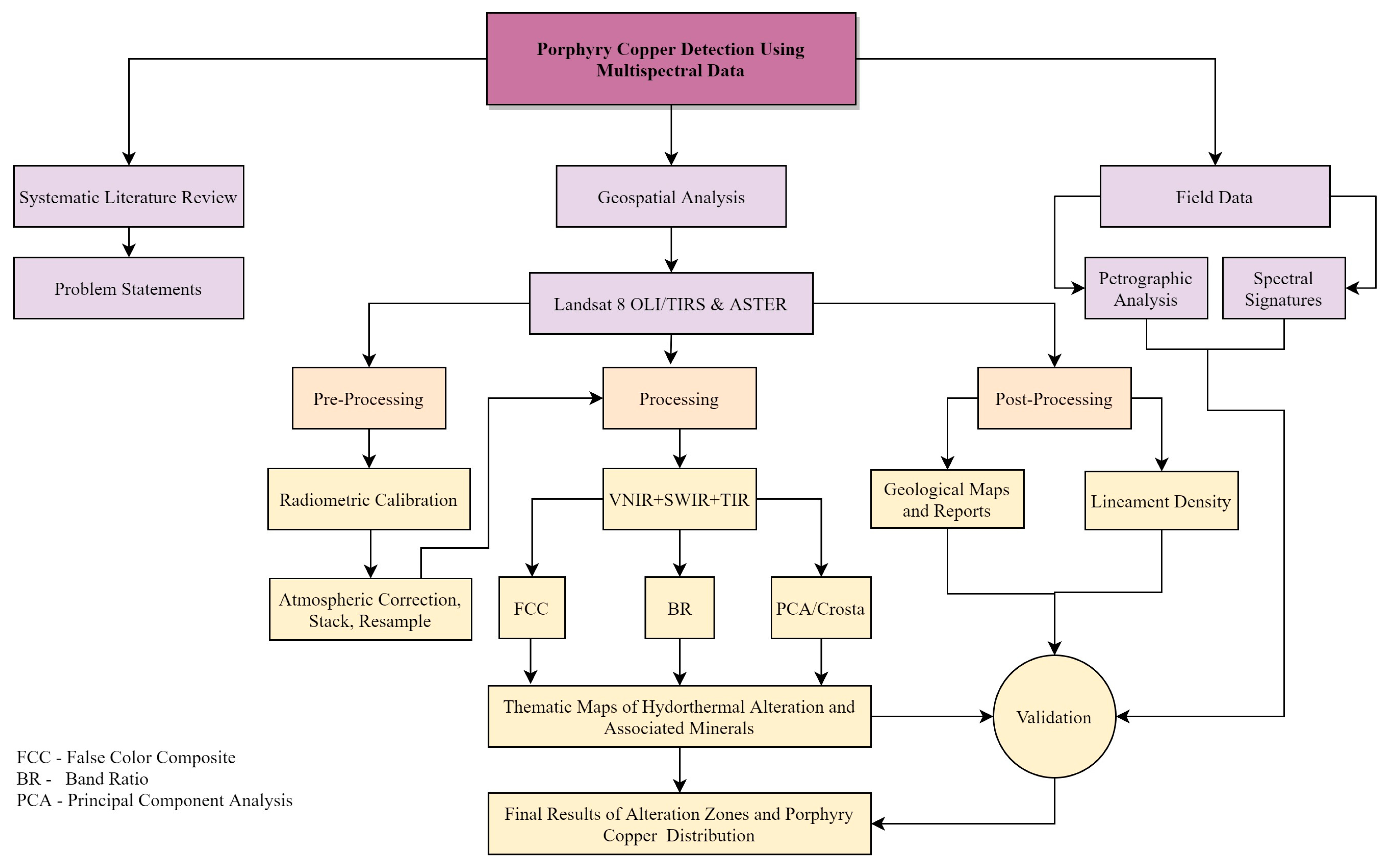

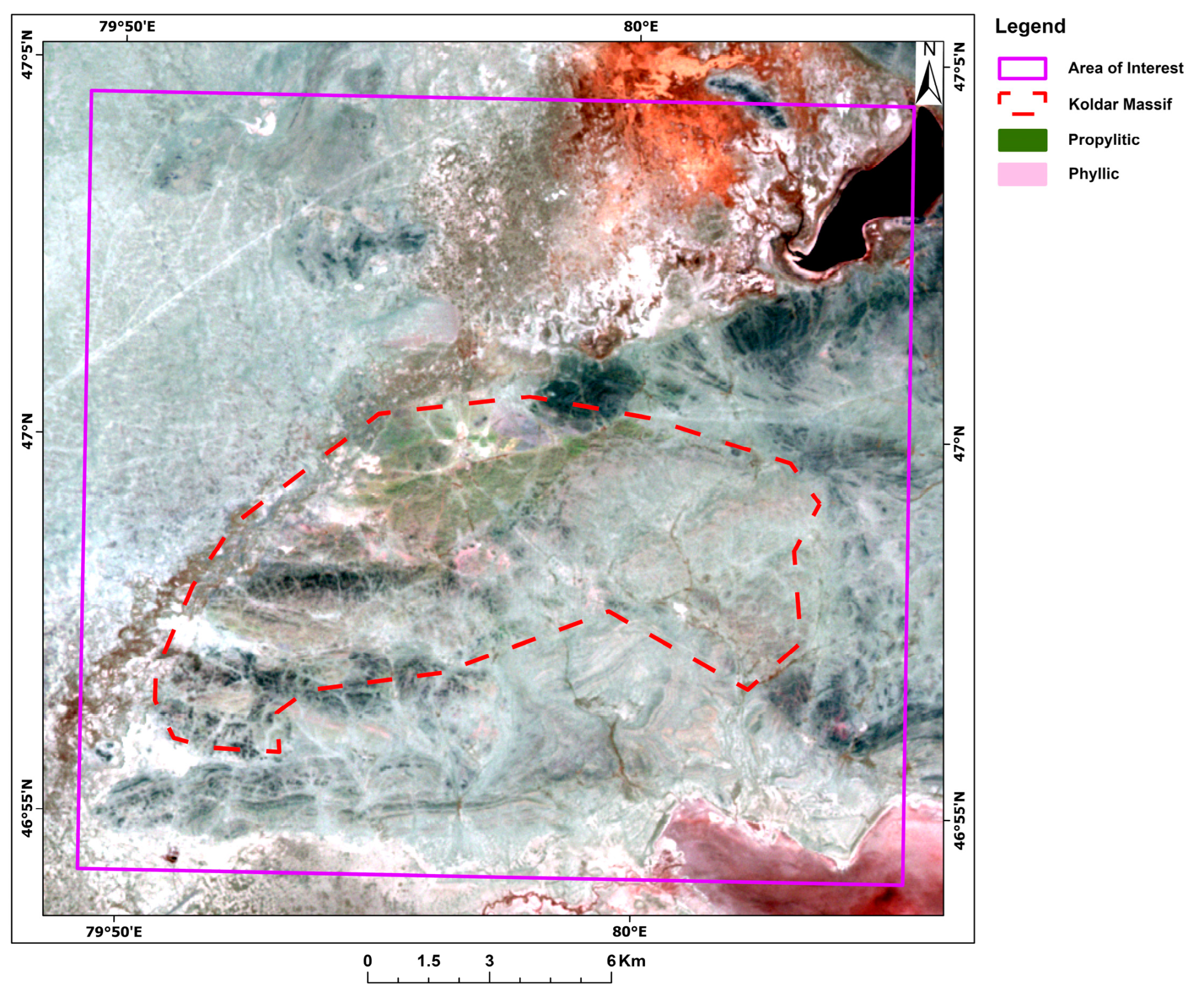
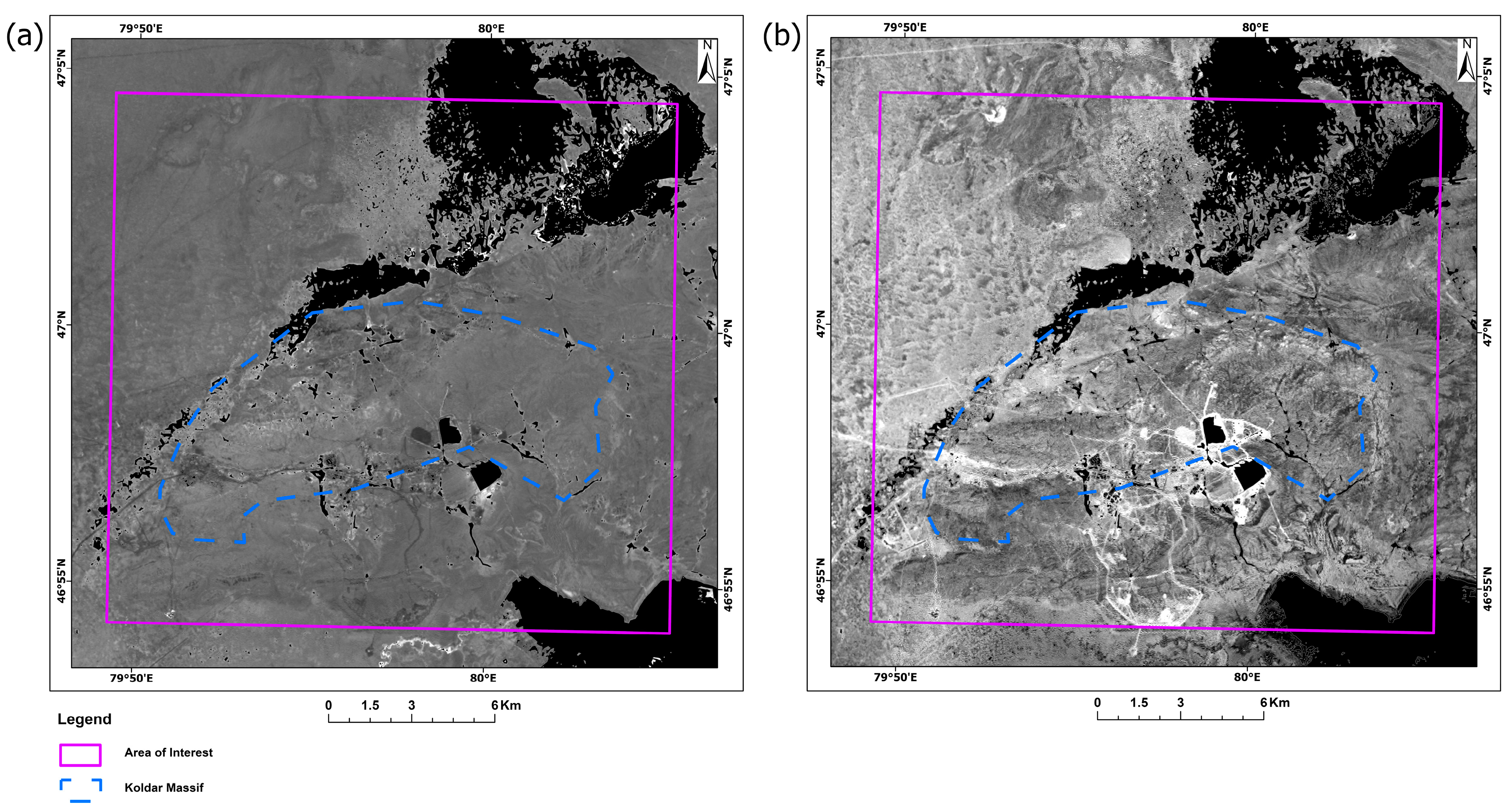
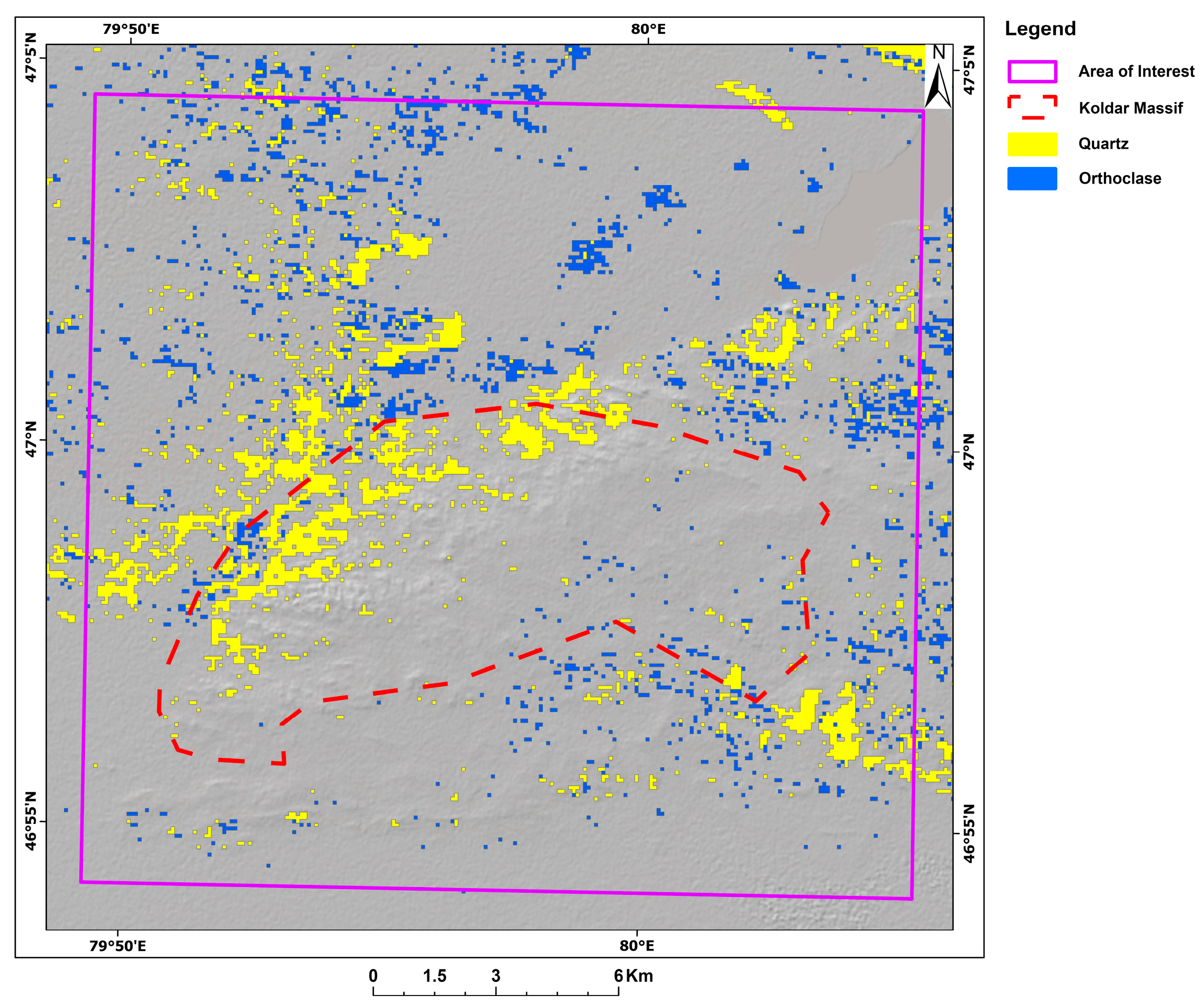
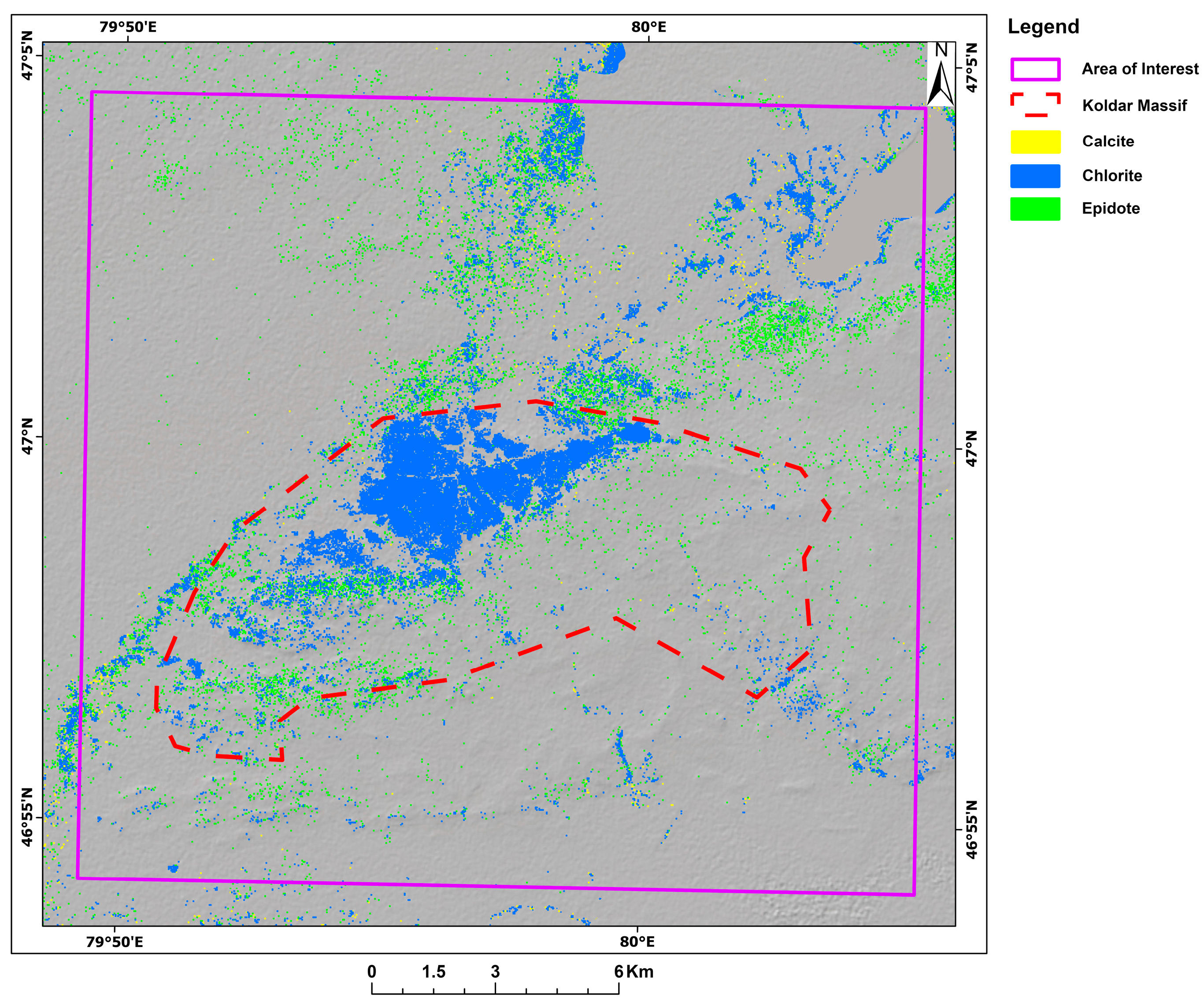

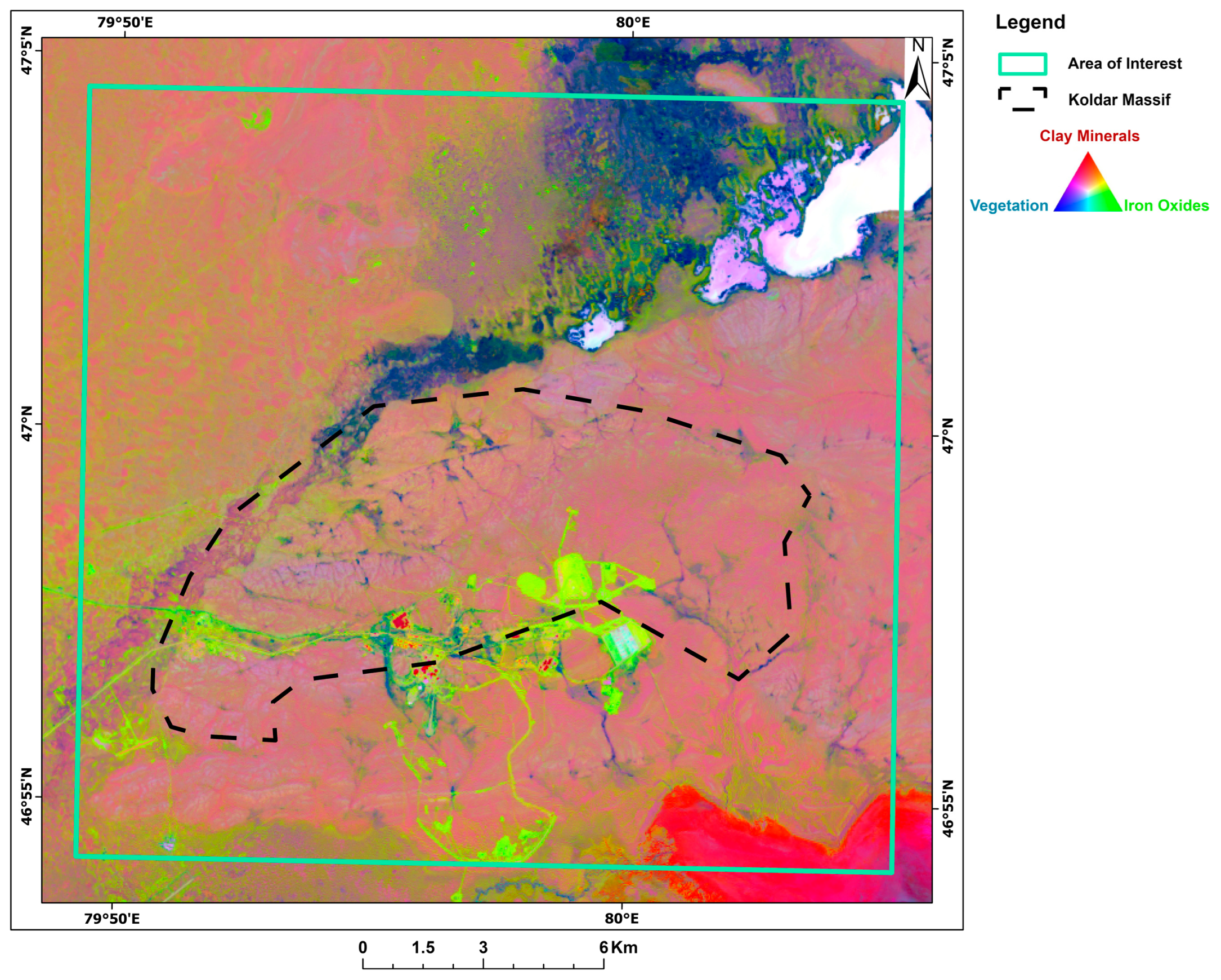

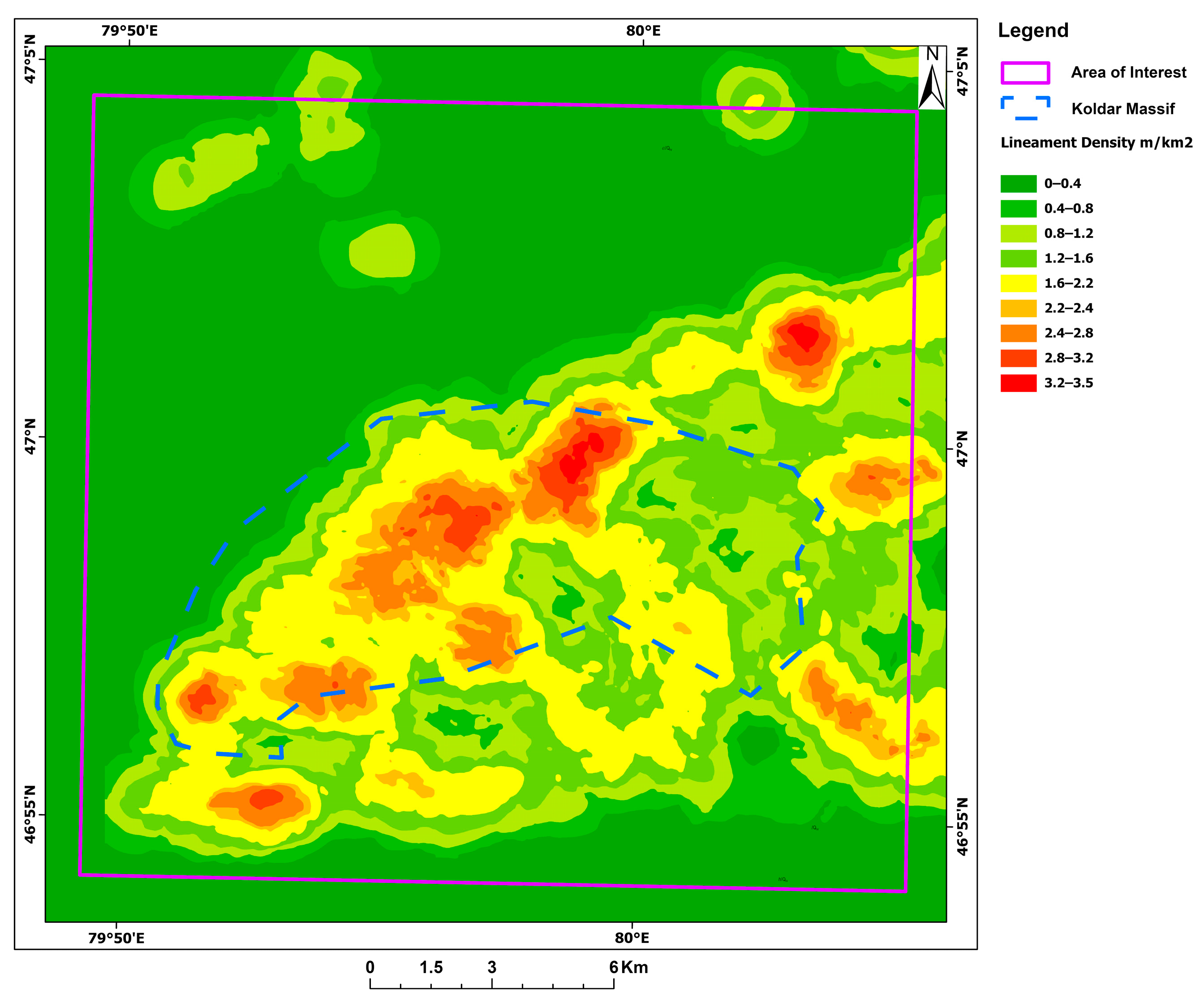

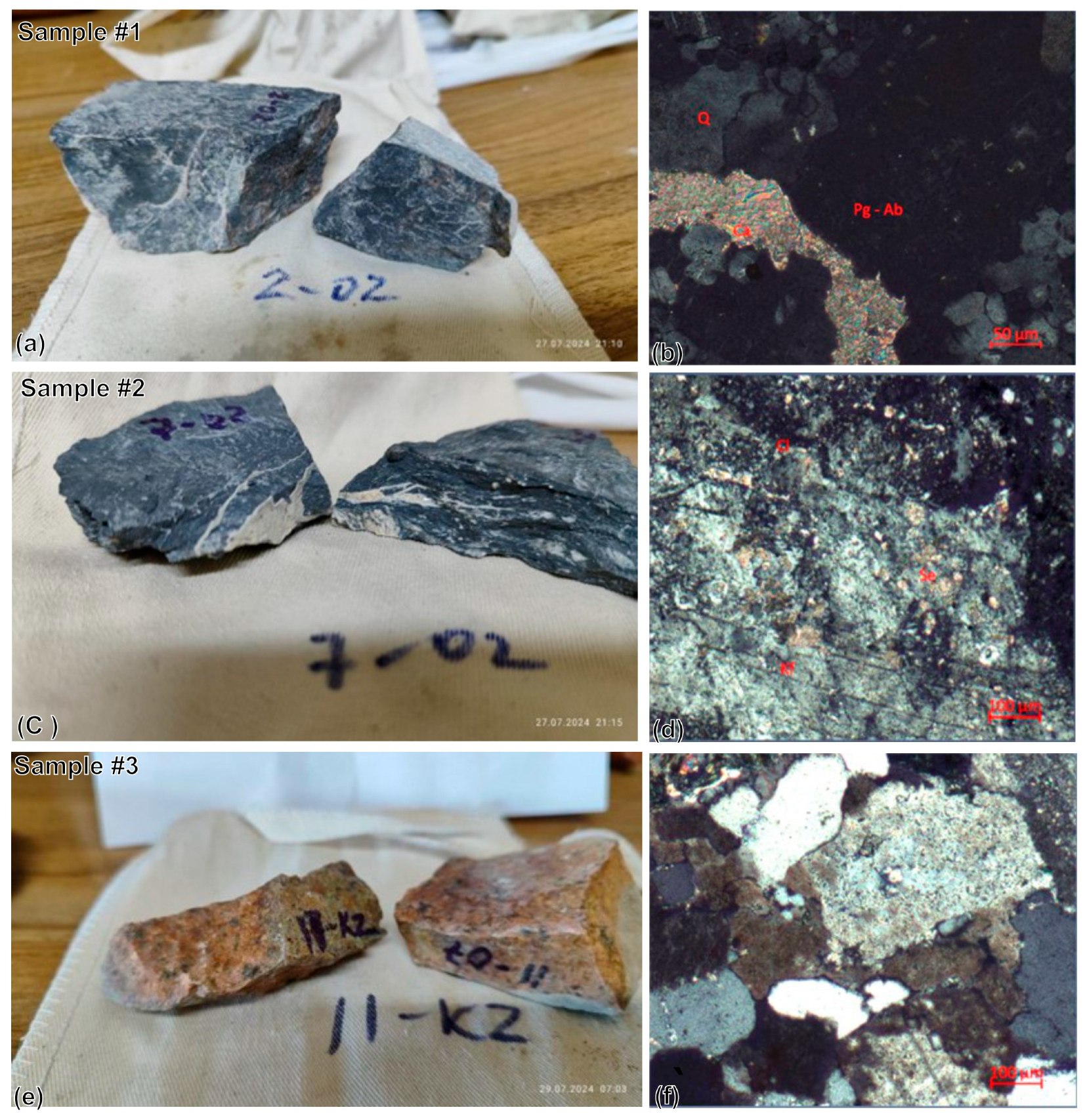
| Data | Scene ID | Longitude | Latitude | Acquisition Date |
|---|---|---|---|---|
| Landsat-8 | LC81480272016236LGN01 | 78.98687 | 48.50331 | 26 August 2016 |
| 82.18349 | 48.51483 | |||
| 79.06726 | 46.35314 | |||
| 82.13620 | 46.36383 | |||
| ASTER | ASTL1A 0408140543090408280116 | 79.26633 | 47.25239 | 14 August 2004 |
| 80.41163 | 47.26399 | |||
| 80.41924 | 46.56428 | |||
| 79.28874 | 46.55295 |
| Principal Components | Eigenvalues | Percentages |
|---|---|---|
| PC1 | 0.043941 | 83.64% |
| PC2 | 0.006789 | 12.92% |
| PC3 | 0.000954 | 1.82% |
| PC4 | 0.000200 | 0.38% |
| PC5 | 0.000042 | 0.08% |
| PC6 | 0.000013 | 0.02% |
| PC7 | 0.000002 | 0.00% |
| PC | Band 1 | Band 2 | Band 3 | Band 4 | Band 5 | Band 6 | Band 7 | ||
|---|---|---|---|---|---|---|---|---|---|
| PC1 | 0.45860 | −0.08737 | −0.22147 | 0.52592 | 0.24505 | 0.33001 | 0.53614 | ||
| PC2 | 0.48096 | −0.06849 | −0.21523 | 0.33449 | 0.05075 | −0.17079 | −0.75765 | ||
| PC3 | 0.46735 | −0.00996 | −0.11856 | −0.24701 | −0.30195 | −0.69731 | 0.35917 | ||
| PC4 | 0.47140 | 0.06295 | −0.10654 | −0.64112 | −0.13518 | 0.56906 | −0.09656 | ||
| PC5 | 0.33860 | 0.29570 | 0.86459 | 0.05424 | 0.21370 | −0.04112 | −0.00986 | ||
| PC6 | −0.03622 | 0.70358 | −0.08674 | 0.30997 | −0.61704 | 0.13896 | 0.00224 | ||
| PC7 | −0.04207 | 0.63337 | −0.35239 | −0.20110 | 0.63365 | −0.17564 | 0.00940 | ||
| Crosta Method—Propylitic Alteration (ASTER Selected Bands) | |||||||||
| Eigenvectors | Band 1 | Band 4 | Band 5 | Band 8 | |||||
| PC1 | 0.2296 | 0.96557 | −0.11753 | 0.03384 | |||||
| PC2 | 0.61042 | −0.04593 | 0.78264 | −0.11291 | |||||
| PC3 | 0.54365 | −0.19536 | −0.32763 | 0.74762 | |||||
| PC4 | 0.52831 | −0.16553 | −0.51605 | −0.65359 | |||||
| Crosta Method—Argillic Alteration (ASTER Selected Bands) | |||||||||
| Eigenvectors | Band 1 | Band 4 | Band 6 | Band 7 | |||||
| PC1 | 0.21881 | 0.96706 | −0.12305 | 0.04201 | |||||
| PC2 | 0.60035 | −0.03299 | 0.79854 | −0.02855 | |||||
| PC3 | 0.55102 | −0.20586 | −0.39759 | 0.70422 | |||||
| PC4 | 0.53673 | −0.14601 | −0.43486 | −0.70817 | |||||
| Sample No. | Sample Name | Longitude | Latitude | Match |
|---|---|---|---|---|
| 1 | A01-0002 | 79.98413775 | 46.96808036 | Yes |
| 2 | A02-0002 | 79.98423027 | 46.9645183 | No |
| 3 | A03-0002 | 79.98258229 | 46.96952351 | Yes |
| 4 | A04-0002 | 79.98176195 | 46.96982209 | Yes |
| 5 | A05-0002 | 79.98163851 | 46.96798282 | No |
| 6 | A06-0002 | 79.98172205 | 46.96629864 | No |
| 7 | A08a-0002 | 79.98108707 | 46.97007974 | Yes |
| 8 | A09-00001 | 79.97969265 | 46.96454635 | Yes |
| 9 | A11-0002 | 79.97949415 | 46.96813403 | Yes |
| 10 | A18-0002 | 79.97393094 | 46.96727211 | Yes |
| 11 | A38-0002 | 79.97654165 | 46.97003219 | Yes |
| 12 | A42-0002 | 79.96866305 | 46.96725641 | No |
| 13 | A43-0002 | 79.97658117 | 46.96446093 | Yes |
| 14 | A44-0000 | 79.9765934 | 46.96810627 | Yes |
| 15 | A50-0002 | 79.98181617 | 46.96465587 | No |
| 16 | A52-0002 | 79.98441393 | 46.97189439 | No |
| 17 | A55-0002 | 79.97524706 | 46.96741214 | Yes |
| 18 | GT11-0002 | 79.98176237 | 46.96298508 | No |
| 19 | GT12-0002 | 79.97700282 | 46.96997452 | Yes |
| 20 | GT13-0002 | 79.97945382 | 46.97196615 | Yes |
| 21 | GT14-0002 | 79.98264518 | 46.97139292 | Yes |
| 22 | GT16-0002 | 79.98713191 | 46.96765388 | Yes |
| 23 | GT17-0002 | 79.98816851 | 46.96627232 | No |
| 24 | GT18-0002 | 79.98300949 | 46.96958956 | Yes |
| 25 | GT19-0002 | 79.98687926 | 46.96276154 | Yes |
| 26 | GT20-0002 | 79.98616986 | 46.96426407 | Yes |
| 27 | GT21-0002 | 79.97751112 | 46.97139257 | Yes |
| 28 | GT29-0002 | 79.96833641 | 46.97040541 | Yes |
| 29 | GT31-0002 | 79.96468751 | 46.96793391 | Yes |
| 30 | KMC_001 | 79.98333261 | 46.965661 | Yes |
| 31 | KMC_021 | 79.9870342 | 46.96507951 | No |
| 32 | KMC_033 | 79.9866313 | 46.96618371 | Yes |
| 33 | KMC_040 | 79.98631934 | 46.96675788 | Yes |
| 34 | KMK-01-0002 | 79.98013357 | 46.96792155 | Yes |
| 35 | KMK-02-0002 | 79.98502933 | 46.967517 | Yes |
| 36 | KMK-03-0002 | 79.98544123 | 46.96442913 | Yes |
| 37 | KMK-04-0002 | 79.98862478 | 46.96536918 | Yes |
| 38 | KMK-05-0002 | 79.9696046 | 46.96639923 | No |
| 39 | KMK-06-0002 | 79.98005513 | 46.96674055 | No |
| 40 | KMK-08-0002 | 79.97827433 | 46.96535971 | No |
| 41 | KMK-09-0002 | 79.9844701 | 46.96365855 | No |
| 42 | KMK-11-0002 | 79.98875178 | 46.96423172 | Yes |
| 43 | KMK-12-0002 | 79.98487374 | 46.96261116 | Yes |
| 44 | KMK-13-0002 | 79.97161723 | 46.96392302 | Yes |
| 45 | KMK-14-0002 | 79.97418363 | 46.97219178 | Yes |
| Total number of matched samples | 32 | |||
| Total number of unmatched samples | 13 | |||
| Overall Accuracy | 71.1% | |||
| Kappa Coefficient | 0.615 | |||
Disclaimer/Publisher’s Note: The statements, opinions and data contained in all publications are solely those of the individual author(s) and contributor(s) and not of MDPI and/or the editor(s). MDPI and/or the editor(s) disclaim responsibility for any injury to people or property resulting from any ideas, methods, instructions or products referred to in the content. |
© 2025 by the authors. Licensee MDPI, Basel, Switzerland. This article is an open access article distributed under the terms and conditions of the Creative Commons Attribution (CC BY) license (https://creativecommons.org/licenses/by/4.0/).
Share and Cite
Orynbassarova, E.; Ahmadi, H.; Adebiyet, B.; Bekbotayeva, A.; Abdullayeva, T.; Beiranvand Pour, A.; Ilyassova, A.; Serikbayeva, E.; Talgarbayeva, D.; Bermukhanova, A. Mapping Alteration Minerals Associated with Aktogay Porphyry Copper Mineralization in Eastern Kazakhstan Using Landsat-8 and ASTER Satellite Sensors. Minerals 2025, 15, 277. https://doi.org/10.3390/min15030277
Orynbassarova E, Ahmadi H, Adebiyet B, Bekbotayeva A, Abdullayeva T, Beiranvand Pour A, Ilyassova A, Serikbayeva E, Talgarbayeva D, Bermukhanova A. Mapping Alteration Minerals Associated with Aktogay Porphyry Copper Mineralization in Eastern Kazakhstan Using Landsat-8 and ASTER Satellite Sensors. Minerals. 2025; 15(3):277. https://doi.org/10.3390/min15030277
Chicago/Turabian StyleOrynbassarova, Elmira, Hemayatullah Ahmadi, Bakhberde Adebiyet, Alma Bekbotayeva, Togzhan Abdullayeva, Amin Beiranvand Pour, Aigerim Ilyassova, Elmira Serikbayeva, Dinara Talgarbayeva, and Aigerim Bermukhanova. 2025. "Mapping Alteration Minerals Associated with Aktogay Porphyry Copper Mineralization in Eastern Kazakhstan Using Landsat-8 and ASTER Satellite Sensors" Minerals 15, no. 3: 277. https://doi.org/10.3390/min15030277
APA StyleOrynbassarova, E., Ahmadi, H., Adebiyet, B., Bekbotayeva, A., Abdullayeva, T., Beiranvand Pour, A., Ilyassova, A., Serikbayeva, E., Talgarbayeva, D., & Bermukhanova, A. (2025). Mapping Alteration Minerals Associated with Aktogay Porphyry Copper Mineralization in Eastern Kazakhstan Using Landsat-8 and ASTER Satellite Sensors. Minerals, 15(3), 277. https://doi.org/10.3390/min15030277









